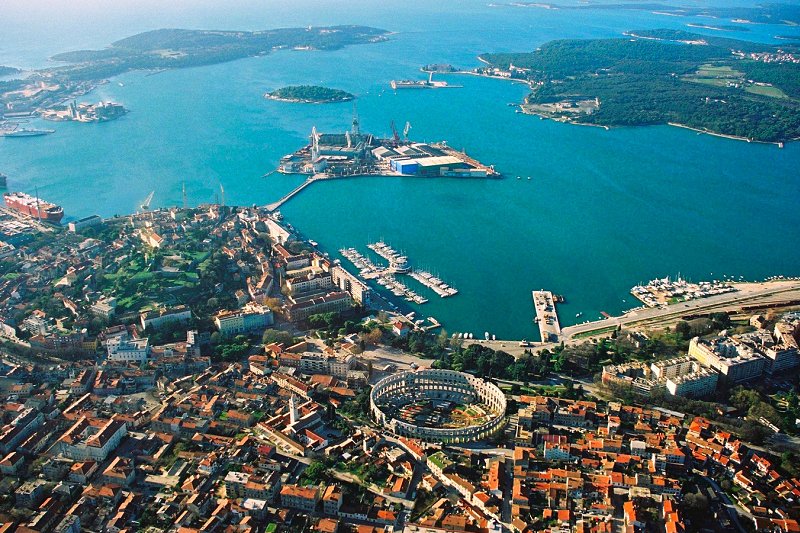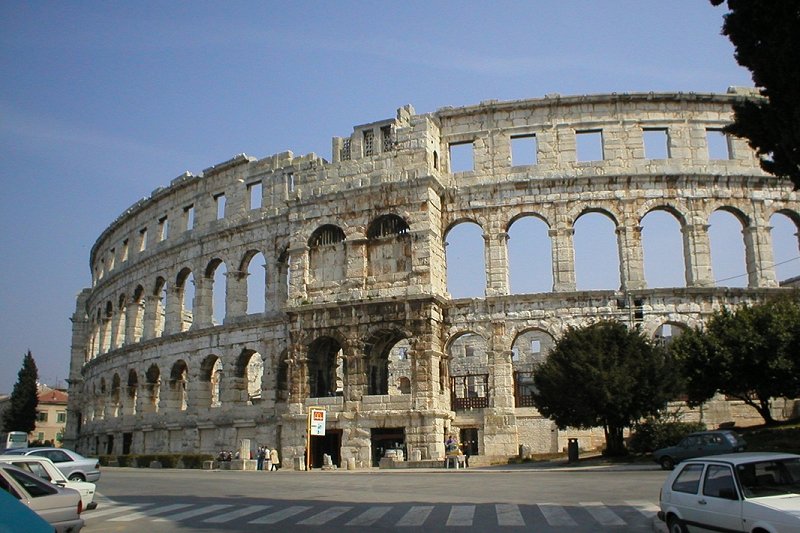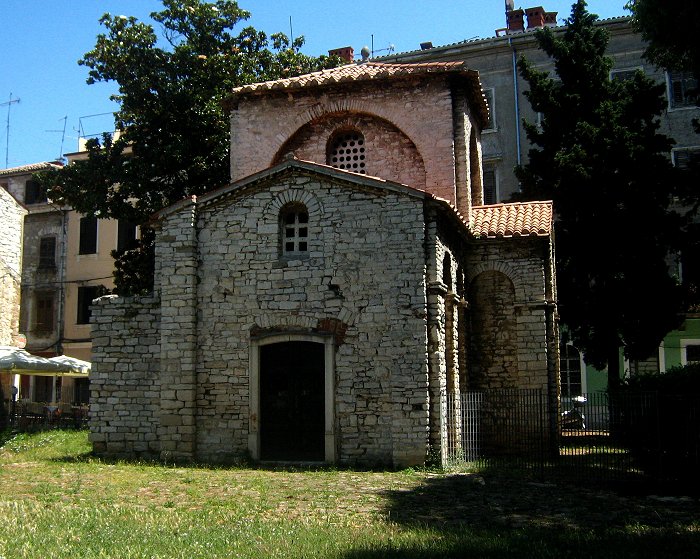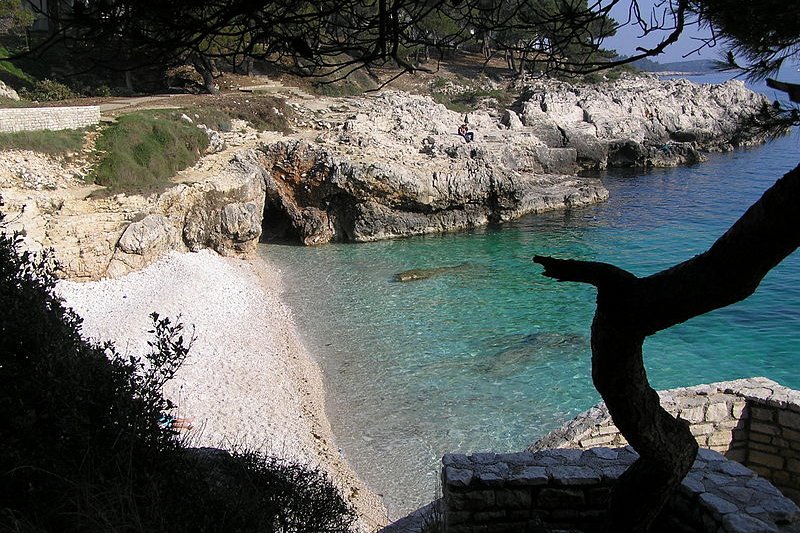 Pula, Croatia
Pula, CroatiaSource: https://commons.wikimedia.org/wiki/File:Pula_Aerial_View.jpg
Author: Orlovic

Pula is a city on the southern tip of the Istria Peninsula, in northwestern Croatia. The city covers 51.65 sq km (19.9 sq mi) and has a population of 62,000 people (2011 estimate).
Located on the inner part of a gulf, Pula enjoys a pleasant Mediterranean climate. The warmest months here are July and August, when the average high temperature may climb to 28°C (82°F). Coldest months are January and February, when the average low drops to 2°C (36°F). September and October are the wettest months, each receiving 85 mm (3.35 in) of precipitation.
Today, as in times past, the economy of Pula is supported by shipbuilding, fishing and tourism. Food processing and winemaking are also major components of its economy. Tourism has become increasingly important, as the town takes advantage of the natural beauty of its jagged landscape.
 Pula Amphitheater
Pula AmphitheaterSource: https://commons.wikimedia.org/wiki/File:Pula-amfiteatar.JPG
Author: Орловић

Pula has a long and winding history. Evidence of human habitation around Pula goes back to prehistoric times. This includes remains of Homo erectus in a cave near Pula. Pottery shards have also been discovered, dating back to the Neolithic period (6000-2000BC). Greek culture established itself in the area in the 10th century BC. The city appeared in Greek mythology, particularly the story of Jason of the golden fleece. It was written as Polai.
The Romans conquered the Istria Peninsula in 177 BC, and brought Roman culture to Pula. The city was part of the Western Roman Empire until 476 AD, when it was destroyed by the Ostrogoths. It was ruled by the Ostrogoths until 538, after which it was absorbed by the Byzantine Empire. Then in AD788 it came under the rule of the Frankish kingdom under Charlemagne. In 1148, the city was captured by the Venetians, and absorbed into the Republic of Venice.
 Church of St Mary of Formosa, Pula
Church of St Mary of Formosa, PulaSource: https://commons.wikimedia.org/wiki/File:Santa_Maria_Formosa_-_Pula.jpg
Author: Rosier-HR

Pula was captured by Pisa in 1192, but subsequently recaptured by Venice. From then on it was a repeat casualty, being ransacked by the Venetians in 1243, followed by the Genoese in 1267 and 1397. The repeated assaults severely weakened Pula. This is further exacerbated by infighting among members of its ruling families. Eventually the Venetian captured Pula again, and ruled it until 1797, when it came under the Austrian Habsburg Empire. When the French defeated the Austrians in 1805, Pula was adeed to the French Empire, under its puppet Kingdom of Italy. It remained part of Italy until 1813, when it was restored to Austrian rule.
The First World War brought an end to the Austro-Hungarian Empire in 1918. Pula and the whole Istria Peninsula, were given to Italy. The Italians ruled Pula until September 1943, when the Nazis took over the city, and made it part of Küstenland, an occupied zone within the Third Reich. After the Second World War, the Istria Peninsula was united as part of Croatia, and in 1947, became part of Yugoslavia. When Yugoslavia disintegrated, it became part of Croatia.
 The beach in Pula, Croatia
The beach in Pula, CroatiaSource: https://commons.wikimedia.org/wiki/File:Pula_beach_%281%29.JPG
Author: Orlovic

Visiting Pula
You can fly to Pula from Zagreb as well as from Amsterdam, Edinburgh, London, Manchester, Oslo, Vienna and Zürich. From the airport, you can take a bus to the main bus terminal in downtown Pula.Places of Interest in Pula
- Arch of the Sergii (Slavoluk obitelji Sergijevaca)
This is the ruins of a Roman arch built in the 1st century BC to honor three brothers who held high positions in the Roman administration. - Archaeological Museum of Istria (Arheološki Muzej Istre)
Museum exhibiting Istrian artifacts from prehistory to the Middle Ages. - Castle and Historical Museum of Istria (Povijesni Muzej Istre)
Castle built in the 14th century over a Roman capitol. Today it houses the regional museum of Istria. - Cathedral (Katedrala)
The Cathedral of the Blessed Virgin Mary has its history going back to the 5th century, after Pula became an episcopal seat. Present structure dates to the 17th century. - Church of St Francis (Sv. Frane)
Church building dating back to the 13th century. Today it houses artifacts from the Imperial Roman era. - Church of St Mary of Formosa (Kapela Marije Formoze)
A small Greek-style Byzantine church, part of the Basilica of St Mary of Formosa. - Church of St Nicholas (Sv. Nikola)
Church that was first built in the 6th century, rebuilt in the 10th, and reassigned to the Orthodox church in the 15th century. - Gate of Hercules (Herculova vrata)
A single-arch gate from the 1st century BC. This is the oldest and best-preserved Roman monument in Pula. - Pula Amphitheatre
Roman amphitheater that accommodates 23,000 spectators. Built by Emperor Vespasian in AD 79, it remained largely intact until the 15th century, when its some of its stones were taken to construct the castle and other buildings in Pula. - Temple of Romae and Augustus (Augustov hram)
Roman temple, an excellent example of Roman architecture, built in the 1st century AD built over the site of an earlier Roman forum. - Twin Gate (Dvojna vrata)
A double-arch gateway dating to the 2nd or 3rd century, today part of the medieval city wall.
 Latest updates on Penang Travel Tips
Latest updates on Penang Travel Tips

Copyright © 2003-2025 Timothy Tye. All Rights Reserved.

 Go Back
Go Back